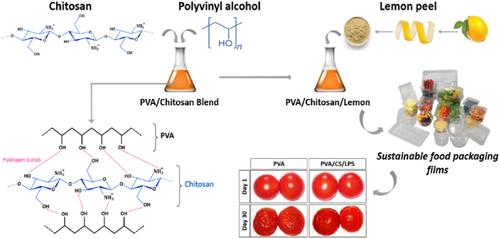将柠檬皮提取物作为聚乙烯醇/壳聚糖混合物的天然添加剂用于高级生物活性食品包装的研究
IF 3.9
3区 化学
Q2 POLYMER SCIENCE
引用次数: 0
摘要
柠檬皮(LP)与聚乙烯醇/壳聚糖(PVA/CS)相结合,通过溶剂浇铸法生产出创新的活性食品包装薄膜。研究人员制备了不同柠檬皮含量(按重量计分别为 1%、3% 和 5%)的 PVA/CS/LP 生物复合材料,以考察它们对 PVA/CS 混合物的形态、热、结构、生物降解性、溶解性、机械和生物活性特性的影响。扫描电子显微镜分析表明,LP 在基质中均匀分散。衰减全反射-傅立叶变换红外光谱(ATR-FTIR)研究证实了柠檬皮与基质之间的相互作用。加入 LP 增强了 PVA/CS 薄膜的热稳定性和酶活性,同时降低了其紫外-可见光透明度。此外,生物复合材料的生物降解性也有所提高,在土壤中埋藏 30 天后,生物降解性达到 74%。水分含量、水溶性和膨胀性随着 LP 含量的增加而降低,有利于食品的保存。拉伸试验表明,将 PVA 与 CS 混合可使杨氏模量提高 17%。在 PVA/CS 混合物中加入 LP 进一步提高了杨氏模量和拉伸强度,分别达到 1322 和 193 兆帕,这归功于 PVA/CS 基质和 LP 之间的强氢键作用。此外,PVA/CS/LP 生物复合材料还有效降低了樱桃番茄的重量损失,并抑制了微生物的生长,这表明它们有望成为用于食品保鲜的生态友好型生物活性包装材料。本文章由计算机程序翻译,如有差异,请以英文原文为准。

Investigation of lemon peel extract as a natural additive in polyvinyl alcohol/chitosan blend for advanced bioactive food packaging
Lemon peel (LP) was integrated into polyvinyl alcohol/chitosan (PVA/CS) to produce innovative active food packaging films via solvent‐casting method. PVA/CS/LP biocomposites were prepared with varying LP contents (1%, 3%, and 5% by weight) to investigate their impact on morphological, thermal, structural, biodegradability, solubility, mechanical, and bioactivity properties of the PVA/CS blend. Scanning electron microscope analysis revealed a uniform dispersion of LP within the matrix. Attenuated total reflectance ‐ fourier transform Infrared spectroscopy (ATR‐FTIR) study confirmed interaction between lemon peel and the matrix. The incorporation of LP enhanced thermal stability and enzymatic activity of PVA/CS films while reducing their UV–vis light transparency. Additionally, the biodegradability of the biocomposites increased, reaching 74% after 30 days of soil burial. Moisture content, water solubility, and swelling decreased with LP content, favoring food preservation. It can be asserted from the tensile test that blending PVA with CS enhances the Young's modulus by 17%. The incorporation of LP into the PVA/CS blend further enhanced the Young's modulus and tensile strength to 1322 and 193 MPa, respectively, attributed to the strong hydrogen bonding between the PVA/CS matrix and LP. Moreover, PVA/CS/LP biocomposites effectively reduced weight loss in cherry tomatoes and inhibited microbial growth, suggesting their potential as eco‐friendly bioactive packaging materials for food preservation.
求助全文
通过发布文献求助,成功后即可免费获取论文全文。
去求助
来源期刊

Journal of Polymer Science
POLYMER SCIENCE-
CiteScore
6.30
自引率
5.90%
发文量
264
期刊介绍:
Journal of Polymer Research provides a forum for the prompt publication of articles concerning the fundamental and applied research of polymers. Its great feature lies in the diversity of content which it encompasses, drawing together results from all aspects of polymer science and technology.
As polymer research is rapidly growing around the globe, the aim of this journal is to establish itself as a significant information tool not only for the international polymer researchers in academia but also for those working in industry. The scope of the journal covers a wide range of the highly interdisciplinary field of polymer science and technology.
 求助内容:
求助内容: 应助结果提醒方式:
应助结果提醒方式:


